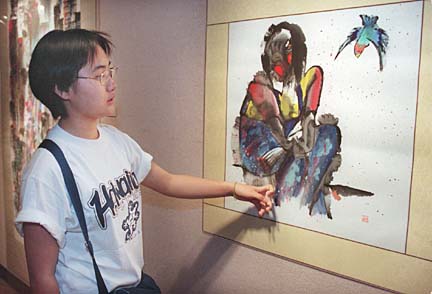


At age 6, Li Qing won her first international award for a brightly colored painting of happy children playing in the sun. She called it, "Who's Taller, The Sun or Me?"
Even then, the young, aggressive artist from Beijing was full of confidence. Now, more than 60 national and international awards later -- and as the youngest exhibitor ever at the East-West Center Gallery -- the 15-year-old Li has made her mark on Chinese art.
Different from the more traditional Chinese landscapes, much of Li's art depicts life in the streets of a Beijing "hutong," the neighborhoods squeezed among mazes of narrow alleys.
"I hope people in Hawaii like the way I paint," she said through an interpreter. "It's very new. This is my adventure."
Hawaii is the first U.S. trip for Li, who speaks some English and understands more. Of Korean ethnicity, she traveled to Seoul for a solo show in 1996. She's won top national and international art awards in China, Korea, Japan, Norway and Italy. This year, she was accepted by Beijing's most prestigious middle school for arts.

Li's solo show of 33 pieces at the East-West Center, with her work spanning age 6 to now, runs through Feb. 18. It includes pen-and-ink sketches, combinations of ink and watercolor and, as she grows older, more abstract art.Ask Li about her favorite pieces, and she goes immediately to her "Story of Our Street Community," sketched when she was 8. A Chinese version of ohana, or extended family, the pen-and-ink drawing includes favorite neighbors of her early childhood hutong, Shi Jing Shan, as they read, chat and play Chinese chess. The drawing is a collage of individual sketches she did over many weeks.
It includes the hutong's favorite grandpa, "who loves to talk and laugh," the story on the drawing reads. But when he models, "he looks like a piece of stone."
And there's the bearded man who is "good and nice but he doesn't respect girls much. How come he lost a game (of Chinese chess) to the girl?"
She also likes her young woman titled "Thinking." At 12, it was Li's first attempt at combining ink and watercolors. The woman, dressed in bold, bright colors, has a dark face, something she says she never sees in Chinese art.
As far profiting from her work, Li said she's sold only one piece to a close friend, and her visa bans selling work here.
Her father, Li Chunnan, who is director of the Korean language division at China National Radio, said the family will only sell art "if someone shows a good appreciation. We didn't expect to make a lot of money."
Any profit will go to further educate his daughter, he said.
Li Qing and her father spent close to three weeks on Oahu and the Big Island. But she came to work, not bask in the spotlight or on the beaches. Sketching her way through public and private schools on Oahu and the Big Island, she's talked with more than 1,000 students of all ages.
Benji Bennington, the East-West Center Gallery's curator, said Li Qing has been a confidence-builder for students here. "If somebody this young can get so much recognition, they feel positive that they can do things themselves," Bennington said.
But Li Qing, who paints three days a week and goes to regular classes another three days, knows getting recognition takes hard work. "Effort is proportional to success," she declares. "Chinese study very hard."
She's surprised by what she sees as a lack of discipline and respect among Hawaii's students, as well as their amount of freedom, and she didn't feel so comfortable with young people her age.
"They are different, very naughty, and in the class they are so casual. In China, the teachers are happier because the students have high respect for teachers. Here the teachers respect the students."
Li Qing is also shocked by the pierced noses and lips she's seen on students. In China, she notes jokingly, "only cows have rings in their noses. (Here) even in elementary they put things on their faces and head."
But she likes the friendly people of Hawaii, the beauty -- she regrets she had no time for the beach -- and the efficient bus system. And some of the more commercial aspects of America have been appealing. Now she wants to try her hand at drawing cartoons.
"I've been sitting in front of the TV watching the cartoons," she said.